Đồ Chua (Vietnamese carrot and daikon pickles) is the popular accompaniment for many Southern Vietnamese dishes.
In this blog post, I will guide you on making Đồ Chua with an easily memorable ingredient ratio and the simplest, yet flavor-centric, approach.

Table of Contents
🙋♀️ What is Đồ Chua?
In Vietnamese, Đồ Chua translates to “Sour Stuff.” It’s prepared through pickling, a method involving soaking food in an acidic brine to create a sour flavor, as opposed to fermentation, where foods sour due to a chemical reaction between naturally present sugars and bacteria.

Much like Korean cuisine with Kimchi and various banchan dishes, pickling and fermenting are also popular cooking techniques in Vietnamese cuisine. In addition to Đồ Chua, we have:
- Dưa Giá (pickled bean sprouts with garlic chives)
- Dưa Món (pickled veggies in fish sauce brine)
- Dưa Chua (fermented mustard greens)
All of them are staple foods during Vietnamese Lunar New Year, alongside traditional main dishes like Bánh Chưng, Xôi Gấc and Chả Giò.
In my opinion, Đồ Chua, together with Mỡ Hành (Vietnamese Scallion Oil), Sốt Sate (Vietnamese lemongrass chili sauce), and Nước Chấm (Dipping Fish Sauce), are staples in Southern Vietnamese cuisine. They are always must-haves in my pantry.
🙋♀️ What to serve with Đồ Chua
Vietnamese cuisine focuses on the balance of flavors and nutrition. That’s why you’ll often find greasy, deep-fried, or high-fat dishes always served alongside an abundance of fresh lettuce, herbs, and a fermented or pickled vegetable side dish.
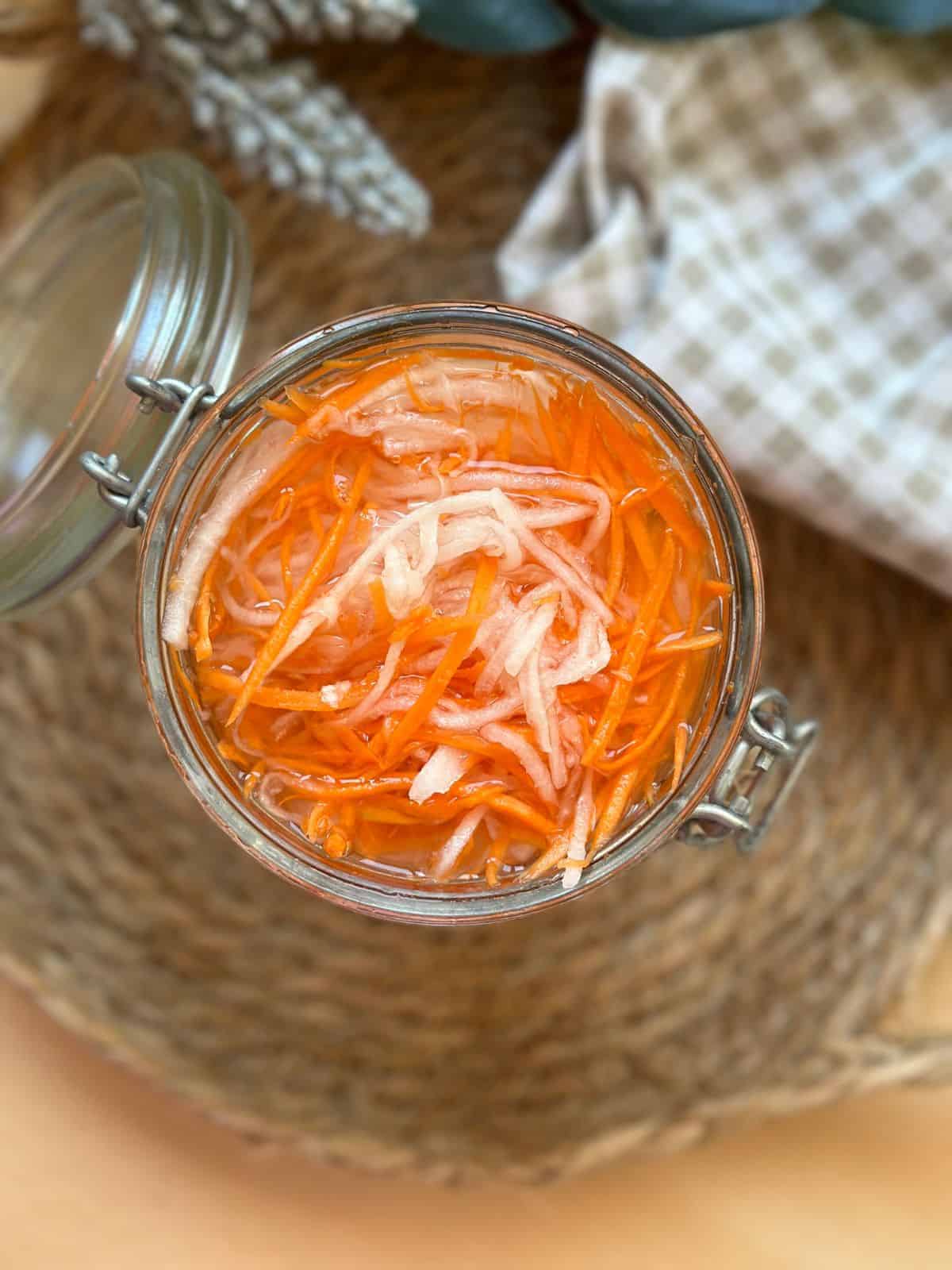
You could find Đồ Chua served with many Southern dishes, such as:
- Rice noodle salads like Bún Bò Xào, Bún Thịt Nướng or Bún Chả Giò.
- Added on Nước Chấm and Peanut Sauce (the dipping sauces for Gỏi Cuốn & Bò Bía).
- Bánh Mì: Đồ Chua, House Mayo, Liver Pâté and Chả Lụa are essential components for Bánh Mì Thịt Nguội, the most popular Bánh Mì in Saigon.

- Bánh Mì Charcuterie Board or the deconstructed Bánh Mì.
- Cơm Tấm (broken rice platter): It’s a part of the Cơm Tấm dish, just like Lemongrass Pork Chops, Steamed Egg Meatloaf, and Shredded Pork Skin (Bì).
- Greasy or deep-fried dishes like Bánh Bột Chiên, Bánh Xèo, Bánh Khọt, or Bánh Tôm.
In the North, Dưa Góp (a similar pickled vegetable side dish) is prepared with carrot and green papaya (or kohlrabi). It is frequently served alongside many of Hanoi’s signature dishes, such as Bún Chả or Hanoi Spring Rolls.

🥕 Ingredients
For the vegetables: The commonly used vegetables for Đồ Chua are carrots and daikon. Kohlrabi is an excellent substitute for daikon.
In my opinion, the ideal ratio of daikon to carrot is 3:2. You can adjust it to your preference, but remember that daikon should outweigh the carrot.
For the brine: the ratio of rice vinegar (5%), sugar, and water is a simple 1:1:1 (easy to remember, isn’t it?).
📝 Instructions
- Peel carrot and daikon.
- Julienne the veggies to your preferred size. You can use a mandolin slicer, a vegetable shredder, or cut them into thin strips by hand. (Ensure the strips maintain some thickness for crunchiness.)
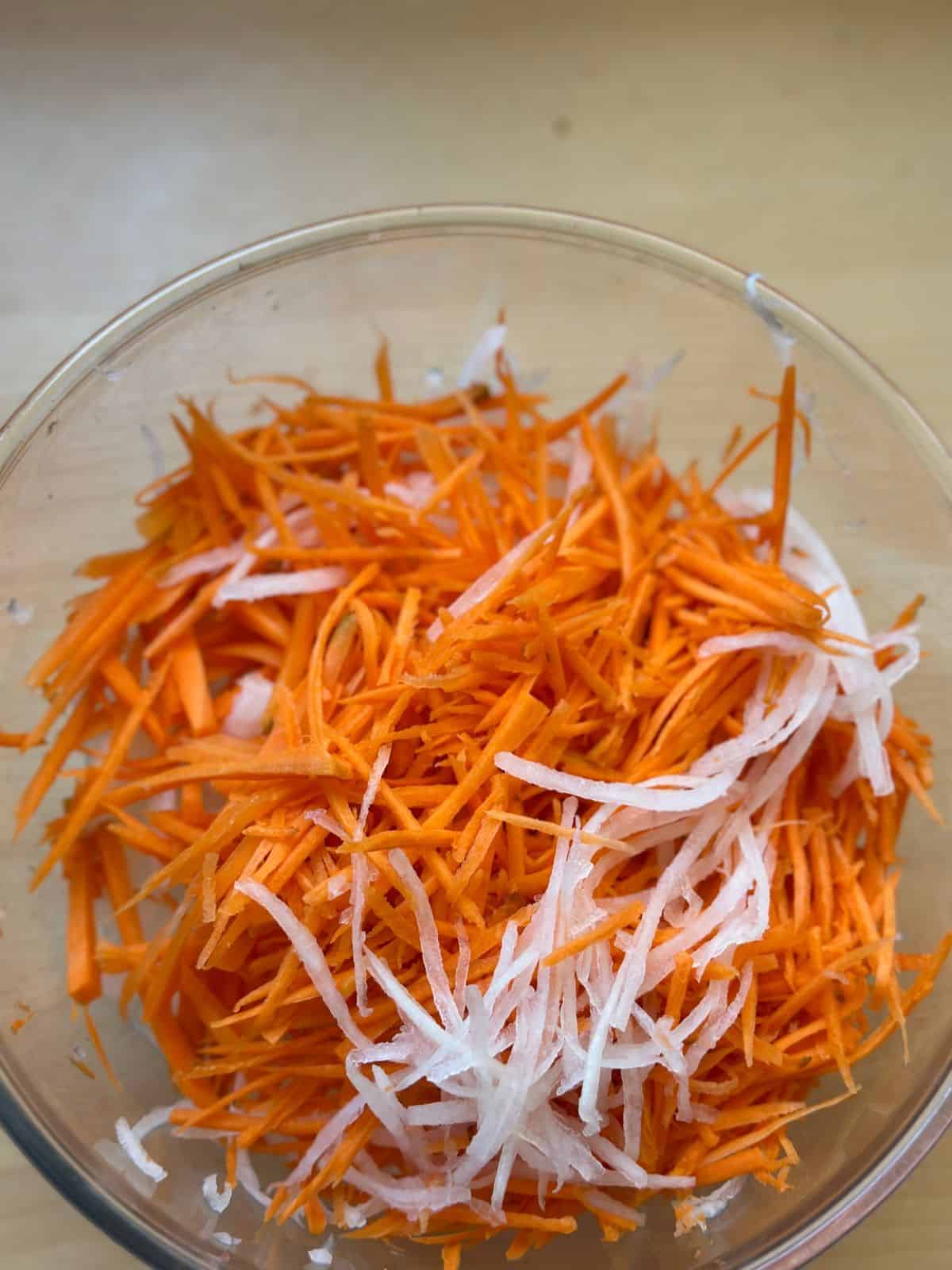
- Create the vinegar solution by combining vinegar, sugar, and water.

- Place the vegetables in a jar or container, then pour in the brining liquid, ensuring everything is submerged.
- Refrigerate it for about 8 hours before enjoying.
❓ FAQ
Do I need to salt the vegetables to remove moisture?
No need to salt the vegetables, but it can help them absorb the brine more quickly. It may also slightly reduce the pungent smell of daikon, but the effect is not very significant. If you choose to do so, refer to my instructions below for making quick Đồ Chua.
📝 Make Đồ Chua in less than 40 minutes
This method is ideal for preparing a smaller batch of Đồ Chua. Salting the vegetables and using warm water for the brine can significantly accelerate brine absorption.

- Toss the veggies with a pinch of salt for 15 minutes (about 1/2 tsp salt for 1.1 lbs / 500g of carrots and daikon). Rinse them thoroughly and gently squeeze to remove excess moisture.
- In a pot, combine water, vinegar, and sugar (ensuring there’s enough liquid to cover all the vegetables). Warm the brine to around 160°F (70°C), stirring well to completely dissolve the sugar.
- Pour the brine over the vegetables. After waiting for 20 minutes, you can enjoy it with various Vietnamese dishes.
🌟 Substitutes
- If daikon is not available, you can substitute it with kohlrabi or green papaya. Actually, I frequently use kohlrabi over daikon since it’s more affordable in Germany.
- You can also use this brine with various other vegetables, such as cucumber, cauliflower, broccoli (both the buds and stems), and morning glory / water spinach (rau muống).
- You could use rice vinegar, apple cider vinegar or distilled vinegar for the brine.
🌟 Helpful Tips
- If you plan to store Đồ Chua for an extended period, remember to sterilize the containers.
- Tossing the veggies with a pinch of salt before brining may slightly reduce the pungent smell of daikon, but not significantly.
- Do not leave the pickles at room temperature, as they could become overly sour.
- Be careful when using mandolin slicer or vegetable shredder since it could be very sharp. Wear a cut-resistant glove during this process.
🍜 More Vietnamese recipes to make at home
Not just a drink, in Vietnam, it’s a cultural icon and is featured in many desserts like Bánh Flan.
Cà Phê Trứng (egg coffee), Cà Phê Muối (salt coffee), and Bạc Xỉu (Saigon white coffee) are also worth trying.
This Vietnamese-style five-spice roast Cornish hen is easy and perfect for festive occasions like Lunar New Year, Thanksgiving, or Christmas.
If you prefer not to cook a whole chicken, try my Gà Roti and Lemongrass Chicken recipes.
Air-fryer fish sauce chicken wings
This is the recipe I adapted from my mom’s Cánh Gà Chiên Nước Mắm. It’s crispy, delectable with a fish sauce glaze, gluten-free, and especially oil-free.
For an even lighter option, you might enjoy my Chinese steamed chicken wings.
Did you find this recipe helpful?
Please leave a 5-star 🌟🌟🌟🌟🌟 rating in the recipe card below! Your support means the world to me! It would greatly inspire me to create more valuable content about Vietnamese and Asian cuisines. Thank you and have a nice day!! Don’t forget to stay in touch with me on Instagram, Facebook, Pinterest, YouTube 🥰.
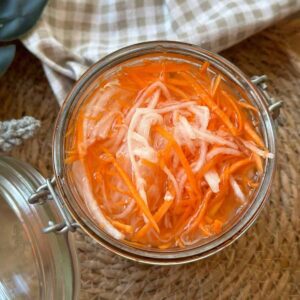
Vietnamese carrot and daikon pickles – Đồ Chua (Easy)
Equipment
- Mandolin slicer
- Vegetable shredder
Ingredients
- 1 lb daikon (450g)
- 0.7 lbs carrot (320g)
- 1.5 cup water (375ml)
- 1.5 cup sugar (375ml)
- 1.5 cup rice vinegar (5%) (375ml)
Instructions
Simple way
- Begin by peeling the carrots and daikon.
- Next, julienne the vegetables to your desired size. You can use a mandolin slicer, a vegetable shredder, or by manually cutting them into thin strips. Maintain some thickness in the strips for a satisfying crunch.
- Prepare the vinegar solution by combining vinegar, sugar, and water.
- Transfer the prepared vegetables into a jar or container, then pour in the brine, ensuring all the vegetables are fully submerged.
- Finally, refrigerate the pickles for about 8 hours before enjoying.
Express Đồ Chua (ideal for a small batch)
- Toss the julienned vegetables with a small pinch of salt for 15 minutes (1/2 tsp salt for 1.1 lbs / 500g of carrots and daikon). Then, rinse them thoroughly and gently squeeze to eliminate excess moisture.
- In a saucepan, mix together water, vinegar, and sugar, ensuring there's sufficient liquid to submerge all the vegetables. Heat the brine to about 160°F (70°C), stirring thoroughly until the sugar is completely dissolved.
- Pour the brine over the prepared vegetables. After a 20-minute wait, your quick Đồ Chua will be ready to enjoy with a variety of Vietnamese dishes.
Notes
- If daikon is unavailable, you can replace it with kohlrabi or green papaya.
- This brine can also be employed with a variety of other vegetables, including cucumber, cauliflower, broccoli (both the buds and stems), and morning glory / water spinach (rau muống).
- For the brine, all rice vinegar, apple cider vinegar, and distilled vinegar work well.
- If you intend to keep Đồ Chua for a long time, don’t forget to sterilize the containers.
- Sprinkling a bit of salt on the veggies before brining can help lessen the strong smell of daikon, but it won’t make a big difference.
- Don’t leave the pickles at room temperature as your pickels will become overly sour.
- When using a mandolin slicer or vegetable shredder, be cautious because they can be quite sharp. It’s a good idea to wear a cut-resistant glove during this process.

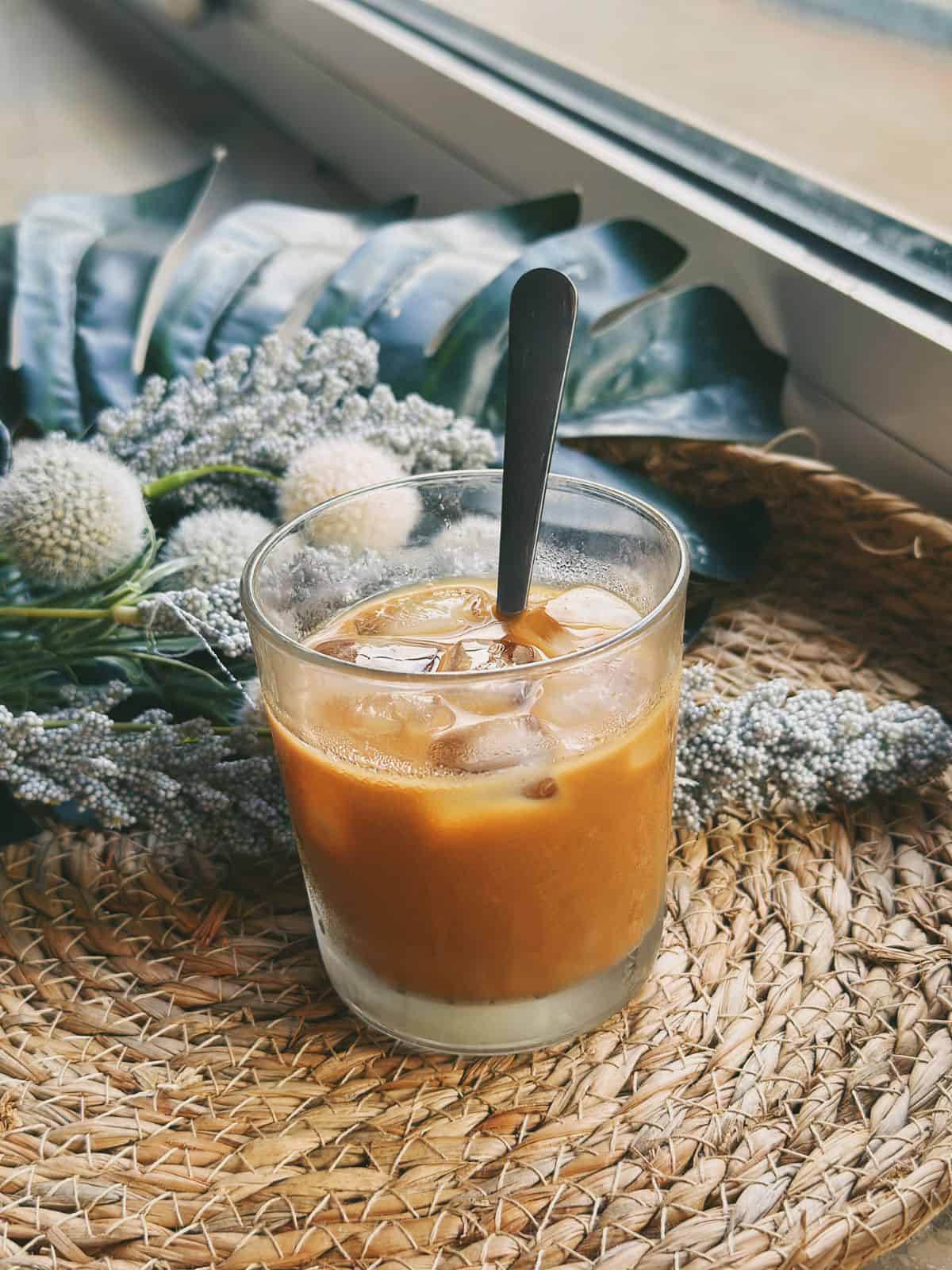




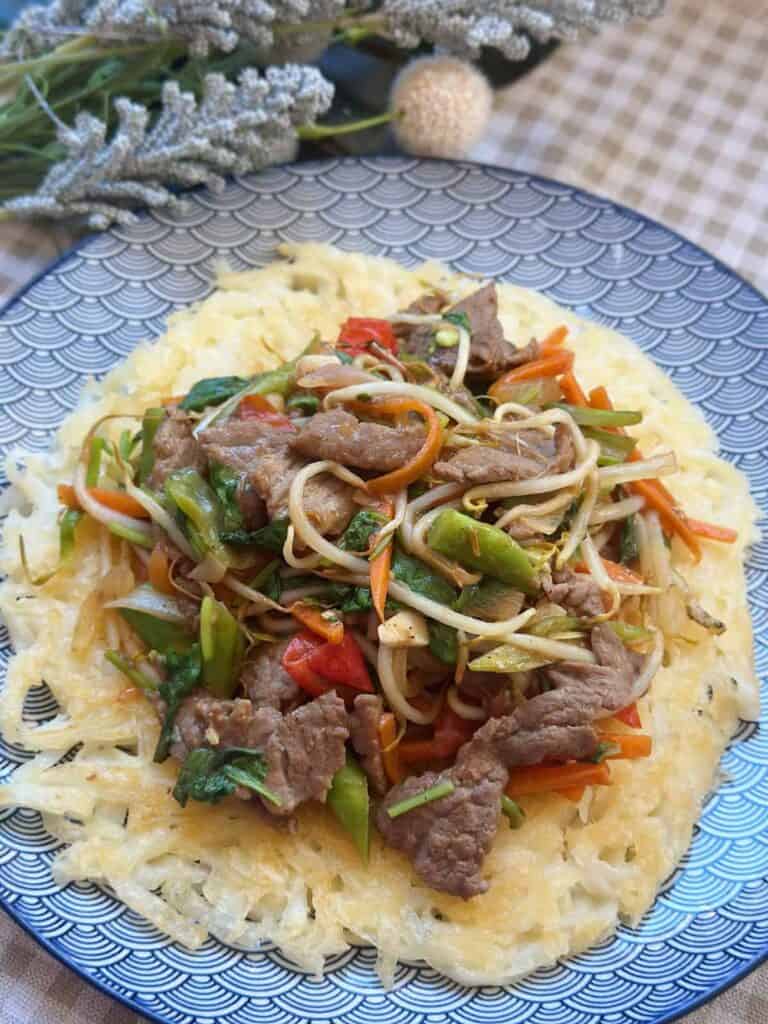

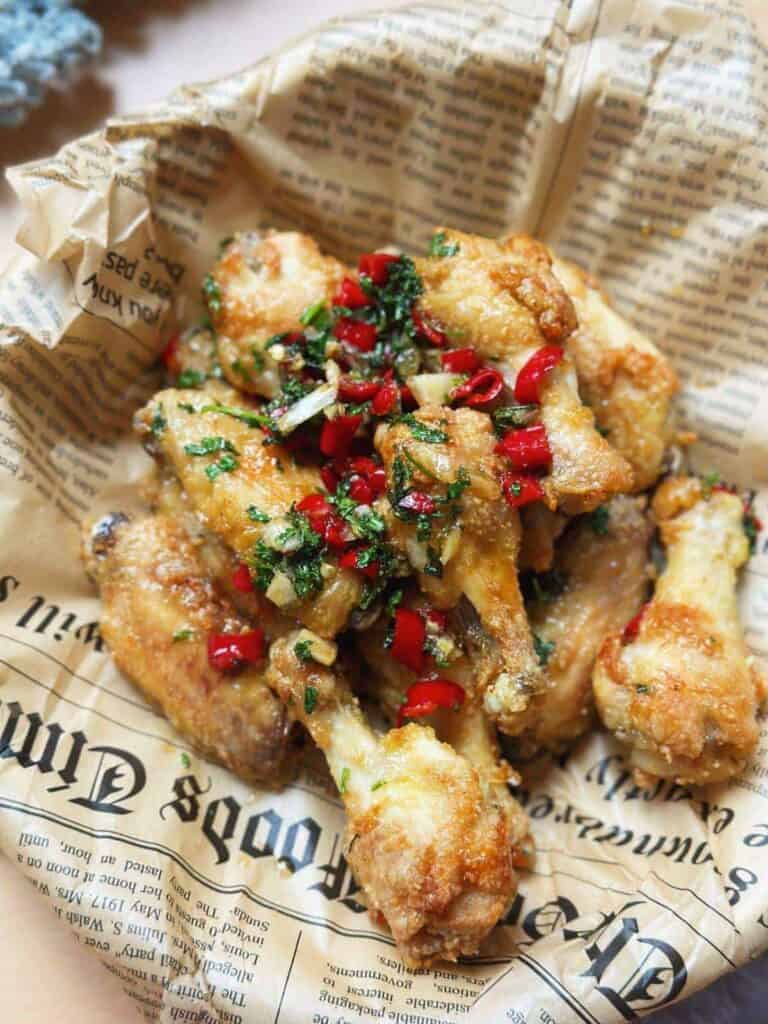
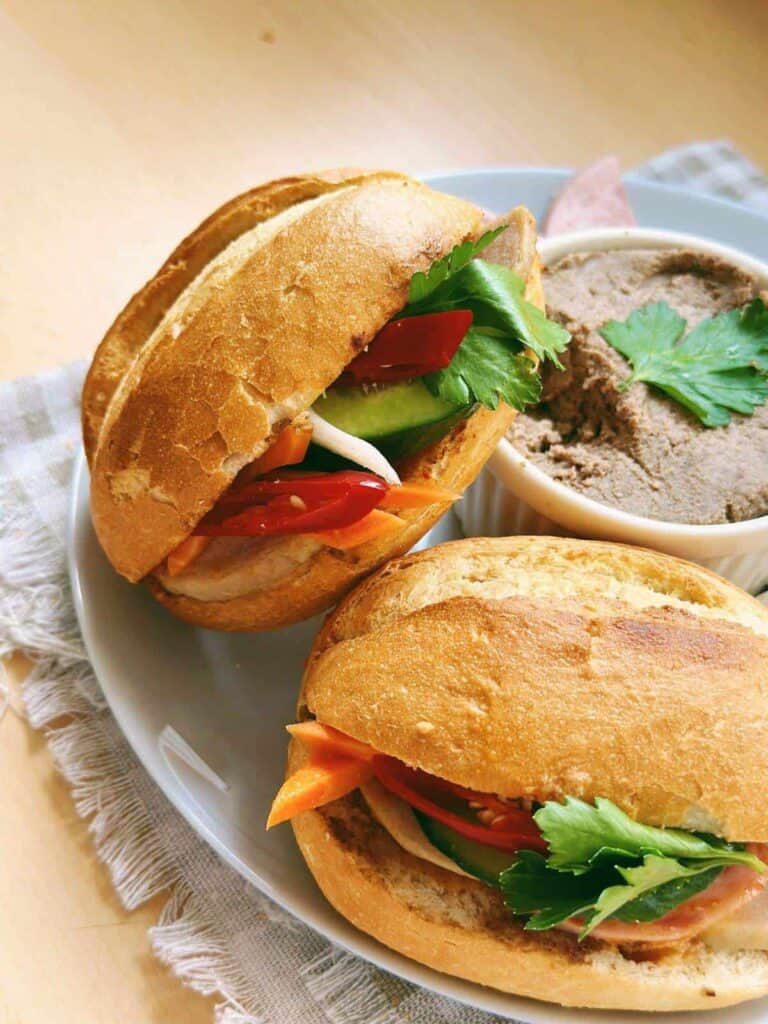
I made this for Banh Mi. It came out so nice. I used only 1/3 of sugar as we are on low carb/starch diet. Thank you for sharing your recipe. Leftover brine I used to pickle leftover cucumber & onions. Also nice. Planning to use the pickles as salad toppings.
Thank you for your feedback. I recommend that you could try my grilled lemongrass pork chops with rice. Add some Vietnamese scallion oil, and then serve them with nước chấm dipping fish sauce and đồ chua (all recipes you can find on my blog). In Vietnam, we call it “cơm sườn nướng”—you won’t be disappointed!!